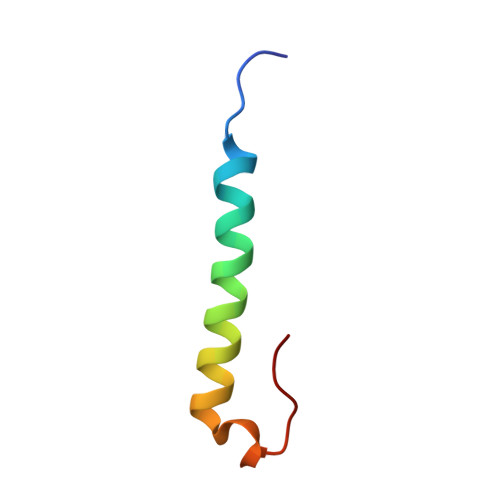Exendin-4 and glucagon-like-peptide-1: NMR structural comparisons in the solution and micelle-associated states.
Neidigh, J.W., Fesinmeyer, R.M., Prickett, K.S., Andersen, N.H.(2001) Biochemistry 40: 13188-13200
- PubMed: 11683627
- DOI: https://doi.org/10.1021/bi010902s
- Primary Citation of Related Structures:
1JRJ - PubMed Abstract:
Exendin-4, a 39 amino acid peptide originally isolated from the oral secretions of the lizard Heloderma suspectum, has been shown to share certain activities with glucagon-like-peptide-1 (GLP-1), a 30 amino acid peptide. We have determined the structuring preferences of exendin-4 and GLP-1 by NMR in both the solution and dodecylphosphocholine (DPC) micelle-associated states. Based on both chemical shift deviations and the pattern of intermediate range NOEs, both peptides display significant helicity from residue 7 to residue 28 with greater fraying at the N-terminus. Thornton and Gorenstein [(1994) Biochemistry 33, 3532-3539] reported that the presence of a flexible, helix-destabilizing, glycine at residue 16 in GLP-1 was an important feature for membrane and receptor binding. Exendin-4 has a helix-favoring glutamate as residue 16. In the micelle-associated state, NMR data indicate that GLP-1 is less helical than exendin-4 due to the presence of Gly16; chemical shift deviations along the peptide sequence suggest that Gly16 serves as an N-cap for a second, more persistent, helix. In 30 vol-% trifluoroethanol (TFE), a single continuous helix is evident in a significant fraction of the GLP-1 conformers present. Exendin-4 has a more regular and less fluxional helix in both media and displays stable tertiary structure in the solution state. In the micelle-bound state of exendin-4, a single helix (residues 11-27) is observed with residues 31-39 completely disordered and undergoing rapid segmental motion. In aqueous fluoroalcohol or aqueous glycol, the Leu21-Pro38 span of exendin-4 forms a compact tertiary fold (the Trp-cage) which shields the side chain of Trp25 from solvent exposure and produces ring current shifts as large as 3 ppm. This tertiary structure is partially populated in water and fully populated in aqueous TFE. The Leu21-Pro38 segment of exendin-4 may be the smallest protein-like folding unit observed to date. When the Trp-cage forms, fraying of the exendin-4 helix occurs exclusively from the N-terminus; backbone NHs for the C-terminal residues of the helix display H/D exchange protection factors as large as 10(5) at 9 degrees C. In contrast, no tertiary structure is evident when exendin-4 binds to DPC micelles. An energetically favorable insertion of the tryptophan ring into the DPC micelle is suggested as the basis for this change. With the exception of exendin-4 in media containing fluoro alcohol cosolvents, NMR structure ensembles generated from the NOE data do not fully reflect the conformational averaging present in these systems. Secondary structure definition from chemical shift deviations may be the most appropriate treatment for peptides that lack tertiary structure.
- Department of Chemistry, University of Washington, Seattle, Washington 98195, USA.
Organizational Affiliation:
















